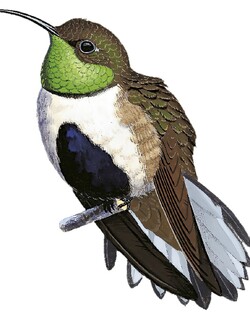Gray-sided Scimitar-Babbler / Megapomatorhinus swinhoei

Gray-sided Scimitar-Babbler
SCI Name:
Protonym: Pomatorhinus Swinhoei Ann.Sci.Nat.Zool.(5), Tome XIX, Article n° 9 p. 5
Taxonomy: Passeriformes / Timaliidae / Megapomatorhinus
Taxonomy Code: gysscb1
Type Locality: western Fukien.
Author: David
Publish Year: 1874
IUCN Status: Least Concern
DEFINITIONS
Megapomatorhinus
(syn. Erythrogenys; Ϯ Large Scimitar-babbler E. hypoleucos) Gr. μεγας megas, μεγαλη megalē great; genus Pomatorhinus Horsfield, 1821, scimitar-babbler; "Megapomatorhinus ([Pomatorhinus]) hypoleucos, erythrocnemis, erythrogenys, swinhoei) ... Megapomatorhinus.— Among the genus names used in the past for the group/members of the group now newly separated from Pomatorhinus based on molecular-genetic markers, none is available according to the Code (ICZN 1999): Orthorhinus Blyth 1844: 124 is preoccupied by Orthorhinus Schönherr 1825, Coleoptera; Erythrogenys E. C. S. Baker 1930, is preoccupied by Erythrogenys Brandt 1841, itself a nomen emendatum of Gould's Erythrogonys. Hodgson's (1836, Asiatic Researches vol. 20: p. 180) use of the name Erythrogenys is without a proper genus description and the original description in the paper refers to a new species only; thus also this name is not available. We therefore formally establish here Megapomatorhinus gen. nov., diagnosed by its general appearance and proportions like Pomatorhinus babblers but generally larger, and in adult birds a curved bill roughly as long as the head, upperparts olive brown to brown, white underparts gradually becoming rusty or brown toward the vent, on breast and/or on flanks striped/dotted light to dark brown/umber, white supercilium lacking or, if present, thin and not reaching distally in front of the eyes, sexes alike; the type species is Orthorhinus hypoleucos Blyth 1844. ... The name acknowledges the similarity to species of Pomatorhinus, but also the large, heavy-bodied, and large-billed nature of species in the named genus." (Moyle et al. 2012); "Recently introduced name Megapomatorhinus is a synonym of Erythrogenys, although latter name was coined accidentally." (del Hoyo & Collar 2016).
swinhoei / swinhoii
Robert Swinhoe (1836-1877) British diplomat in China, Vice-Consul in Taiwan 1860-1866, linguist, collector, naturalist (syn. Aegithalos caudatus glaucogularis, syn. Bubo bubo kiautschensis, syn. Chlidonias hybrida, syn. Cuculus micropterus, subsp. Cyanopica cyanus, Erythrogenys, subsp. Lioparus chrysotis, subsp. Lonchura striata, Lophura, syn. Merops leschenaultii, syn. Oriolus chinensis diffusus, subsp. Picoides canicapillus, syn. Platalea minor, subsp. Stachyris strialata).
SUBSPECIES
Gray-sided Scimitar-Babbler (swinhoei)
SCI Name: Megapomatorhinus swinhoei swinhoei
swinhoei / swinhoii
Robert Swinhoe (1836-1877) British diplomat in China, Vice-Consul in Taiwan 1860-1866, linguist, collector, naturalist (syn. Aegithalos caudatus glaucogularis, syn. Bubo bubo kiautschensis, syn. Chlidonias hybrida, syn. Cuculus micropterus, subsp. Cyanopica cyanus, Erythrogenys, subsp. Lioparus chrysotis, subsp. Lonchura striata, Lophura, syn. Merops leschenaultii, syn. Oriolus chinensis diffusus, subsp. Picoides canicapillus, syn. Platalea minor, subsp. Stachyris strialata).
Gray-sided Scimitar-Babbler (abbreviatus)
SCI Name: Megapomatorhinus swinhoei abbreviatus
abbreviata / abbreviatus
L. abbreviatus short-, shortened, abbreviated < abbreviare to shorten < brevis short.
• "Buteo Cuv. ... 320. B. abbreviatus Cab. Falco abbreviatus Licht. in Mus. Berol. ... Nackenfedern sowie der grössere Theil des kleinen Gefieders am Grunde weiss und ausserdem mit mehr oder weniger grossen weissen Flecken, welche durch die dunkeln Spitzen und Ränder der Federn verleckt, in der Regel nur deutlich sichtbar werden sobald das Gefieder sich verschiebt." (Cabanis 1849) (syn. Buteo albonotatus).
• "Penthestes gambeli abbreviatus, new subspecies Short-tailed Mountain Chickadee ... Tail (see figs. 2, 3) much shorter than in either gambeli or inyoensis; and bill averaging smaller than in any of the other three races."(Grinnell 1918) (syn. Poecile gambeli baileyae).
• "Unser Exemplar von Peru, (mithin Tschudi's ambiguus,) hat eine Schnabellänge von 5⅔" ... Ein Exemplar unsers Museums aus der Küstengegend von Neu-Granada, von Porto Cabello, betrachte ich jedoch als zusondernde Abart: R. abbreviatus n. sp. Merklich kleine; Schnabel wenig über 4½" lang" (Cabanis 1862) (subsp. Ramphastos ambiguus).
UPPERCASE: current genus
Uppercase first letter: generic synonym
● and ● See: generic homonyms
lowercase: species and subspecies
●: early names, variants, mispellings
‡: extinct
†: type species
Gr.: ancient Greek
L.: Latin
<: derived from
syn: synonym of
/: separates historical and modern geographic names
ex: based on
TL: type locality
OD: original diagnosis (genus) or original description (species)












